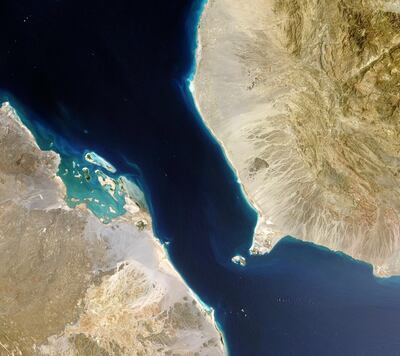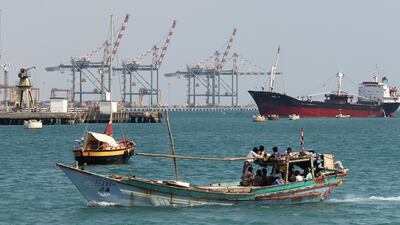After Iran’s president Hassan Rouhani obliquely hinted at a threat to regional oil exports if sanctions blocked Iran’s oil sales, attention turned to the wrong strait.
While the focus was on the Arabian Gulf exit of Hormuz, two Saudi Aramco tankers were apparently attacked by Houthi forces in the Bab El Mandeb at the southern end of the Red Sea, one suffering light damage.
In response, Saudi Aramco temporarily halted oil shipments through Bab El Mandeb. It’s not clear whether the attacks were directly encouraged by Iran, done with its approval or against its wishes. But an incident in the Red Sea can act as a warning shot without the direct attribution that would attach to Hormuz.

Most concern on regional oil transit has focused on the potential cut-off of oil shipments through the Strait of Hormuz, some 18 million barrels per day of crude and almost 4 million bpd of refined products. But this is not the biggest danger.
Saudi Arabia’s pipeline Petroline to Yanbu on the Red Sea can carry about 5 million barrels per day and is being expanded to 7 million bpd by the end of this year, although some is required to feed local refineries. The associated 3.5 million bpd Muajjiz export terminal on the Red Sea is being reopened. Abu Dhabi’s pipeline from Habshan to Fujairah on the Indian Ocean, outside the strait, has capacity of 1.5 million bpd, about half of the emirate’s exports.
As prices would rise sharply during a closure, Saudi Arabia and Abu Dhabi might even gain in revenues despite shipping lower volumes. Oman, which exports from Mina Al Fahal on the Gulf of Oman outside Hormuz, is developing another terminal and an oil storage hub at Duqm in its south. Duqm could eventually be connected to Oman’s neighbours’ pipelines to provide a back-up for exports.
_______________
Read more:
Maximal pressure, minimum impact: how US-Iranian war of words is unlikely to be matched with action
Iran guards threaten to block Strait of Hormuz after Rouhani warning
_______________
By contrast, Kuwait, Qatar and Bahrain are entirely dependent on the strait. Apart from the autonomous Kurdish region, Iraq too requires Hormuz for all its current exports, while the connection to the pipeline through Turkey remains cut. Despite some discussions with Saudi Arabia, Iraq has not regained access to the 1.65 million bpd IPSA pipeline to the Red Sea which was seized after the First Gulf War, and its planned pipeline to Aqaba in Jordan remains on paper.
Members of the International Energy Agency, most of the developed countries, are required to hold storage of at least 90 days of net imports. The US’ Strategic Petroleum Reserve has more, though it is mostly light crude, which would not be a good substitute for Gulf medium and heavy grades. China’s own strategic stocks, about 34 days of import cover, are planned to rise to 90 days by 2020, while India’s are limited to about 10 days.
If a Hormuz blockade reduced Gulf exports by about 13 million barrels per day, worldwide strategic stocks ought to be enough for almost six months of cover. For a while, logistical chaos would ensue, as tankers, refineries and crude grades were shuffled around – careful contingency plans would be vital. Prices would rocket during the closure but slump again as soon as it was over.
Military studies suggest that an obstruction of Hormuz, by mines, small submarines, "swarming" attacks by boats, and land-based missiles, would be defeated within a few weeks at most by US and allied naval forces. It would also be a casus belli for the US to make a much wider-ranging strike against Iranian military and other targets.
The economies of China, Japan, South Korea and the EU would be directly threatened. The US, now a major oil producer, is still a net importer but would suffer less, while Russia would greatly benefit.
Meanwhile, Iran needs the strait for virtually all its oil exports. Despite long-running plans, it has still not developed a pipeline to the port of Jask on the Gulf of Oman. So an attempted halt to oil exports would be economic and diplomatic suicide, only to be attempted as a last resort.
A stop to Hormuz oil shipments may be the most headline-grabbing worry for policymakers, and the most striking threat Iran can make. But it is the wrong place to look for the most damaging impacts.
With its back to the wall, Iran might attack points of offshore oil and gas installations, which are more vulnerable and would take much longer to repair. In 1986, a platform in Abu Dhabi’s Abu Al Bukhoosh field, possibly confused with Iran’s nearby Salman field, was damaged by Iraqi air attack.
A Hormuz blockade would create more problems for liquefied natural gas (LNG) exports rather than for oil. Qatar exports a quarter of the world’s LNG, all through Hormuz, and countries such as South Korea, Japan and Taiwan are entirely dependent on LNG imports for gas. Russia would take the chance to step up supplies to Europe, bolstering its geopolitical influence. Gas is stored in much smaller volumes than oil, especially if – with US sanctions due in force in November - a closure struck during the high-demand northern hemisphere winter.
And imports into the Gulf are crucial. Apart from Saudi Arabia, the UAE’s east coast and Oman, the Gulf countries bring in all their seaborne supplies via Hormuz. Essential goods could come overland from the Saudi Red Sea coast or Jordan, or by air, but this would be logistically challenging and even a short interruption would be damaging. Several countries have invested in emergency food stocks for this reason. International businesses and expatriates operating in the region would lose confidence and might not quickly return.
A long-term closure of Hormuz is, as long as the US opposes it, an idle threat. The threat to oil is also overstated. A single-minded focus on one much-wargamed scenario should not obscure more dangerous and innovative threats.
Robin M Mills is CEO of Qamar Energy, and author of The Myth of the Oil Crisis


